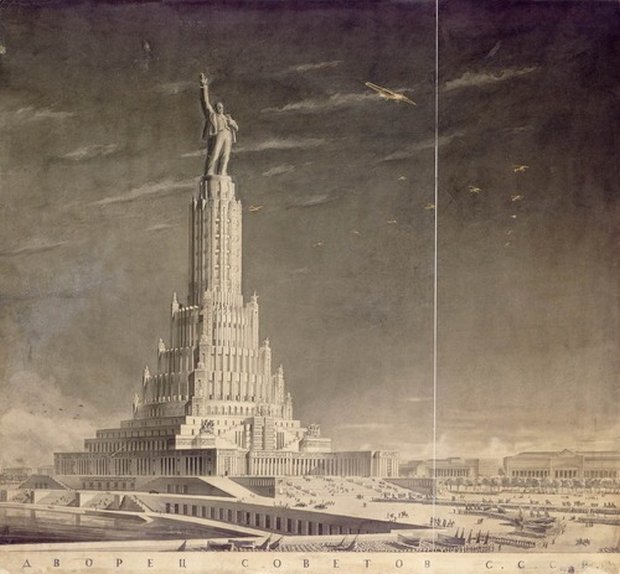I pass the building below twice a week, early in the morning. It’s the Cathedral of Christ the Saviour, a building the history of which shares the tragic fate of Russia and the Russian Orthodox Church of the last two centuries: tsarist splendour, ruthlessness and absurdity of stalinism, practical provisionality of the late communism and the return of tsarist splendour. It is also a building which annoys me every time I see it and the mere existence of which I do not understand.

The temple of the proletariat
The Cathedral was first erected as a votive offering for the victory over Napoleon in 1812, but because of multiple corruption cases and fraud of the money collected for it (and collected among the people, let me add) it was opened only fifty years later, in 1883. It was standing there, not bothered by anybody, for about sixty more years, until Stalin decided to blow it up as a part of the plan of systematic eradication of religion. In the thus emptied square he intended to erect this beautiful construction:

It is The Palace of the Soviets, a building which was intended to demonstrate the power of the Soviet communism to the European proletariat. The Palace was supposed to be 415 meters high; Lenin’s finger was supposed to be six meters long, his foot – fourteen meters. Absurdities of stalinism.

Look before you leap
The constructors only managed to build the foundation. Then the construction plans needed to be abandoned due to the outbreak of the Second World War. After the war the empty square was occupied by a giant outside pool, open all year round – the water was being warmed up. In the nineties a decision was made to rebuild the Cathedral. The money for it was collected among Moscow’s business elite and rumour has it that it was an offer the businessmen could not refuse. The works were completed in the year 2000 and since then the Cathedral of Christ the Saviour is the most important Orthodox church in the country. Putin and other important politicians make sure they are seen there during the celebrations of the most important holidays: the tsarist splendour is back.
In Russia, never ask why
I see this white, marble giant at least four times a week and I am still amazed by the fact that it was built from scratch in a country going through a very painful political and economic transition, in a country of deficit, in a country still crawling. Why, out off all the important causes, this one was chosen? When the Cathedral was destroyed it was a little over fifty years old, so it wasn’t a great historical monument. The original Cathedral was destroyed many, many years before, so in the 90s there were very few people left who would remember it. It wasn’t destroyed by a just-conquered enemy, like the Old Town in Warsaw (the attitude of some Russians to the era of stalinism remains, to say the least, ambiguous). It was not re-erected from the ruins or remnants, it was built from scratch. It was built because the new, weak political authorities desperately needed the support of the re-emerging religious authorities.
The Cathedral was erected – allegedly – for the people and out of their will, but, as it’s usually the case in Russia, the authorities and the people function in two separate, non-crossing planes (and the civil and religious authorities are pretty much one and the same, in accordance with a long Orthodox tradition). It is particularly well visible in the Russian Orthodox churches. The service there is conducted in a language nobody can understand; it is also long and laborious and the attendants cannot sit down throughout its duration (and even if they wanted, there is nowhere for them to do so). Thus, the participation in a service requires from them a fair dose of sacrifice and discipline. At the same time, the faithful don’t seem to need the priests and the rituals. Elderly ladies in flowery headscarfs and gentleman crumpling their hats in their hands join in and wander away from the mass near the iconostasis whenever they only wish. They confess their problems and worries to the icons of the saints spread out around the whole church: they buy and light up long, narrow candles made of bee wax, bow down and make the cross across their chests three times, putting three fingers together and touching their right arm before the left. Then they just walk out, not paying much attention to batyushka (as Russians call Orthodox priests) singing behind their backs.
Give to Caesar what belongs to Caesar …
I wouldn’t like to be misunderstood: I have a great respect to all forms of celebrating true faith. There are very few traits in people that impress me more than the ability to truly live in accordance to what they believe in (and blind following of sets of arbitrary rules is not what I mean here. What I mean is a true, conscious, deep faith). Every single part of me, however, rebels against the cynical people ruthlessly taking advantage of the natural human need of believing in something ‘on the other side’. In the Orthodox Churches there is God and there is the institution, and the former doesn’t seem to have much to do with the latter.

While writing this post I have consulted the following sources: 1, 2, 3.
Liked Samovar? Tell your friends about it! You can find social media links at the bottom of the page.